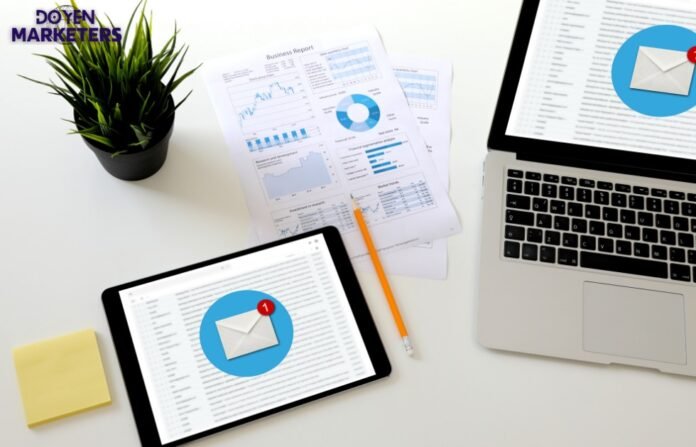Are you looking to fuel your inbound strategy with email marketing? If so, you’re not alone. Email marketing is a powerful tool that can help you attract, engage, and retain customers. In this article, we’ll explore the basics of email marketing and its importance in your overall inbound strategy.
So, what is email marketing? At its core, email marketing is the practice of sending promotional messages to a group of people via email. These messages can include anything from newsletters to special offers to event invitations. The goal of email marketing is to build relationships with your customers and keep them engaged with your brand over time.
Key Takeaways:
- Email marketing is a powerful tool that can help you attract, engage, and retain customers.
- At its core, email marketing is the practice of sending promotional messages to a group of people via email.
- By implementing email marketing into your inbound strategy, you can build stronger relationships with your customers and drive more sales.
What is Email Marketing?
Table of Contents
- 1 What is Email Marketing?
- 2 Importance of Email Marketing
- 3 Inbound Strategy: An Overview
- 4 How Email Marketing Fuels Inbound Strategy
- 5 Implementing Email Marketing into Your Inbound Strategy
- 6 Case Studies: Successful Integration of Email Marketing and Inbound Strategy
- 7 Conclusion
- 8 Frequently Asked Questions
- 8.1 What are some best practices for email segmentation in an inbound strategy?
- 8.2 How can you effectively send one email to multiple lists?
- 8.3 What are the benefits of using email in an inbound marketing strategy?
- 8.4 What are some key elements of a successful inbound email marketing strategy?
- 8.5 How does segmentation help ensure the right message is delivered to the right person?
- 8.6 What are some common mistakes to avoid in an inbound email marketing strategy?
Email marketing is a form of digital marketing that involves sending commercial messages to a group of people via email. It is a cost-effective way of reaching out to potential customers and maintaining relationships with existing ones. Email marketing can be used to promote products or services, share news and updates, provide valuable content, and more.
Email marketing can fuel your overall inbound strategy by providing a direct line of communication with your audience. With email marketing, you can reach people who have already shown an interest in your brand or product, making it easier to convert them into customers. You can also use email marketing to nurture leads and move them through the sales funnel.
Email marketing can be highly targeted, allowing you to send personalized messages to specific groups of people based on their interests, behavior, and demographics. This can improve engagement rates and increase the likelihood of conversions.
To get the most out of email marketing, it’s important to follow best practices and avoid common mistakes. This includes building a quality email list, creating compelling subject lines and content, optimizing for mobile devices, and tracking and analyzing your results.
Overall, email marketing can be a powerful tool for fueling your overall inbound strategy. By using email marketing to connect with your audience, you can build relationships, drive traffic and sales, and achieve your marketing goals.
Importance of Email Marketing
Email marketing is a critical component of your inbound marketing strategy. It is a cost-effective way to reach your target audience and build relationships with them. With email marketing, you can create personalized messages that resonate with your subscribers and keep them engaged with your brand.
One of the main benefits of email marketing is that it allows you to nurture leads and move them through your sales funnel. By sending targeted messages to specific segments of your audience, you can provide them with the information they need to make a purchase decision. This can lead to higher conversion rates and increased revenue for your business.
Another advantage of email marketing is that it provides you with valuable data that you can use to optimize your campaigns. You can track open rates, click-through rates, and other metrics to see how your messages are performing. This information can help you refine your messaging and improve your overall strategy.
Email marketing also allows you to stay top-of-mind with your audience. By sending regular messages, you can keep your brand in front of your subscribers and build trust with them over time. This can lead to increased loyalty and repeat business.
In summary, email marketing is an essential part of your inbound marketing strategy. It allows you to reach your target audience, nurture leads, and build relationships with your subscribers. By using email marketing effectively, you can drive more revenue for your business and improve your overall marketing performance.
Inbound Strategy: An Overview
As a marketer, you know how important it is to attract and retain customers. Inbound marketing is a strategy that can help you do just that. By creating content that is valuable to your audience, you can attract potential customers to your website and convert them into loyal customers.
Definition of Inbound Strategy
Inbound marketing is a customer-centric approach to marketing that focuses on creating valuable content that attracts potential customers to your website. The goal is to provide helpful information that solves problems and answers questions for your target audience. By doing so, you can establish trust and credibility with your audience, which can lead to increased brand awareness, website traffic, and conversions.
Key Elements of Inbound Strategy
There are several key elements of inbound marketing that you should be aware of:
- Buyer Personas: In order to create content that resonates with your audience, you need to understand who they are and what they care about. Buyer personas are fictional representations of your ideal customers that can help you create targeted content that speaks to their needs and interests.
- Content Creation: Content is the backbone of inbound marketing. By creating valuable content that addresses your audience’s pain points and interests, you can attract potential customers to your website and establish your brand as a thought leader in your industry.
- Search Engine Optimization (SEO): SEO is the process of optimizing your website and content to rank higher in search engine results pages (SERPs). By optimizing your content for keywords that your audience is searching for, you can increase your visibility and attract more traffic to your website.
- Lead Nurturing: Once you’ve attracted potential customers to your website, you need to nurture them through the sales funnel. Lead nurturing involves providing valuable content and information to your leads to help them make informed decisions and move closer to a purchase.
- Analytics and Reporting: In order to measure the effectiveness of your inbound marketing efforts, you need to track and analyze your website traffic, lead generation, and conversion rates. By doing so, you can identify areas for improvement and make data-driven decisions to optimize your strategy.
By incorporating these key elements into your inbound marketing strategy, you can attract and retain more customers and fuel your overall marketing efforts.
How Email Marketing Fuels Inbound Strategy
Email marketing can be an effective way to fuel your overall inbound strategy. By using email marketing, you can generate leads, nurture them with personalized content, and improve your conversion rates. In this section, we’ll explore how email marketing can help you achieve these goals.
Lead Generation Through Email Marketing
Email marketing can be a powerful tool for lead generation. By building an email list, you can reach a large audience of potential customers who have already shown an interest in your company. You can use email marketing to promote your products or services, offer exclusive deals or discounts, and provide valuable content that your audience will find useful.
To generate leads through email marketing, you can use a variety of tactics, including:
- Offering a lead magnet, such as a free ebook or whitepaper, in exchange for an email address
- Running a contest or giveaway that requires participants to provide their email address
- Creating a landing page that promotes your email list and encourages visitors to sign up
Nurturing Leads with Personalized Content
Once you’ve generated leads through email marketing, it’s important to nurture them with personalized content. By sending targeted emails that address your audience’s specific needs and interests, you can build trust and establish a relationship with your leads.
To nurture leads with personalized content, you can:
- Segment your email list based on factors such as interests, demographics, and behavior
- Use dynamic content to personalize your emails based on each recipient’s preferences
- Send automated emails that provide relevant content at the right time in the buyer’s journey
Improving Conversion Rates
Email marketing can also help you improve your conversion rates by encouraging leads to take action. By including calls-to-action (CTAs) in your emails and making it easy for leads to purchase your products or services, you can increase your conversion rates and drive revenue.
To improve your conversion rates with email marketing, you can:
- Use clear and compelling CTAs that encourage leads to take action
- Include product recommendations or reviews in your emails to help leads make informed purchasing decisions
- Use A/B testing to optimize your emails and improve your conversion rates over time
In conclusion, email marketing can be a valuable tool for fueling your overall inbound strategy. By using email marketing to generate leads, nurture them with personalized content, and improve your conversion rates, you can drive more traffic, leads, and revenue for your business.
Implementing Email Marketing into Your Inbound Strategy
Email marketing is a powerful tool that can fuel your overall inbound strategy. By implementing email marketing, you can increase engagement with your audience, drive traffic to your website, and ultimately generate more leads and sales. Here are some key steps to follow when integrating email marketing into your inbound strategy:
Segmenting Your Audience
One of the most important steps in email marketing is to segment your audience. This means dividing your email list into different groups based on specific criteria, such as demographics, interests, and behavior. By segmenting your audience, you can create targeted and personalized email campaigns that are more likely to resonate with your subscribers.
To segment your audience, start by collecting data on your subscribers. This can include information such as their age, location, job title, and past interactions with your brand. You can then use this data to create segments and tailor your email content accordingly.
Crafting Engaging Email Content
Once you have segmented your audience, it’s time to create engaging email content that will capture their attention. This can include anything from newsletters and promotional offers to educational content and event invitations.
When crafting your email content, make sure to keep your audience’s interests and preferences in mind. Use attention-grabbing subject lines, clear and concise copy, and eye-catching visuals to make your emails stand out. And don’t forget to include a clear call-to-action that encourages your subscribers to take action.
Measuring and Analyzing Success
Finally, it’s important to measure and analyze the success of your email marketing campaigns. This can help you identify what’s working well and what needs improvement, so you can continually optimize your strategy.
Start by tracking key metrics such as open rates, click-through rates, and conversion rates. Use this data to identify trends and patterns in your audience’s behavior, and adjust your strategy accordingly. And don’t be afraid to experiment with different approaches to see what works best for your brand.
By following these steps, you can effectively implement email marketing into your inbound strategy and drive meaningful results for your business.
Case Studies: Successful Integration of Email Marketing and Inbound Strategy
If you are looking for examples of how email marketing can fuel your overall inbound strategy, here are a few case studies to consider:
Case Study 1: HubSpot
HubSpot, a marketing software company, has successfully integrated email marketing into their inbound strategy. They use email to nurture leads and move them through the sales funnel. For example, they send a series of automated emails to new subscribers to educate them about their products and services. They also use email to promote their blog content and webinars.
The results speak for themselves. HubSpot’s email campaigns have an average open rate of 40% and a click-through rate of 10%. They have also seen a 60% increase in revenue from email marketing over the past year.
Case Study 2: Airbnb
Airbnb, an online marketplace for short-term lodging, uses email marketing to engage with their customers and provide personalized recommendations. For example, they send emails to customers who have recently booked a trip with recommendations for local restaurants and activities.
Airbnb also uses email to promote their referral program, which rewards customers who refer their friends to the platform. As a result, they have seen a 300% increase in referral bookings over the past year.
Case Study 3: Grammarly
Grammarly, a writing assistant tool, uses email marketing to educate and engage with their users. They send a weekly newsletter with writing tips and advice, as well as personalized emails with suggestions for improving users’ writing.
Grammarly’s email campaigns have an average open rate of 25% and a click-through rate of 5%. They have also seen a 400% increase in revenue from email marketing over the past year.
By following these examples, you can see how email marketing can be a powerful tool for fueling your overall inbound strategy.
Conclusion
In conclusion, email marketing can be a powerful tool to fuel your overall inbound strategy. By creating targeted and personalized emails, you can engage with your audience and build a relationship with them. This can lead to increased brand awareness, higher website traffic, and ultimately, more sales.
To make the most of your email marketing efforts, it’s important to keep a few things in mind. First, always focus on providing value to your subscribers. This means delivering content that is relevant, informative, and engaging. Second, make sure your emails are visually appealing and easy to read. Use formatting like bullet points, bold text, and images to break up the content and make it more digestible.
Another key aspect of successful email marketing is segmentation. By dividing your subscribers into different groups based on their interests and behaviors, you can send more targeted and effective emails. This can lead to higher open and click-through rates, as well as more conversions.
Finally, it’s important to track and analyze your email marketing metrics. This will help you understand what’s working and what’s not, so you can make data-driven decisions to improve your strategy over time.
Overall, email marketing can be a valuable addition to your inbound strategy. By following best practices and staying focused on your audience’s needs, you can create a powerful marketing channel that drives results for your business.
Frequently Asked Questions
What are some best practices for email segmentation in an inbound strategy?
Email segmentation is the process of dividing your email list into smaller groups based on specific criteria. Some best practices for email segmentation include segmenting based on subscriber behavior, demographics, interests, and engagement levels. By segmenting your email list, you can personalize your messages and increase the chances of engagement.
How can you effectively send one email to multiple lists?
To send one email to multiple lists, you can use a tool that allows you to merge multiple lists into one. You can also segment your email list based on specific criteria and send targeted messages to each segment. However, it’s important to avoid sending duplicate messages to subscribers who are on multiple lists.
What are the benefits of using email in an inbound marketing strategy?
Email is a powerful tool for inbound marketing because it allows you to build relationships with your subscribers, nurture leads, and drive conversions. Email marketing can also help you increase brand awareness, generate leads, and retain customers.
What are some key elements of a successful inbound email marketing strategy?
Some key elements of a successful inbound email marketing strategy include creating valuable content, segmenting your email list, personalizing your messages, optimizing your emails for mobile devices, and tracking your results. It’s also important to comply with email marketing laws and regulations.
How does segmentation help ensure the right message is delivered to the right person?
Segmentation helps ensure the right message is delivered to the right person by allowing you to target specific groups of subscribers based on their interests, behavior, and demographics. By delivering targeted messages to each segment, you can increase the chances of engagement and conversions.
What are some common mistakes to avoid in an inbound email marketing strategy?
Some common mistakes to avoid in an inbound email marketing strategy include sending too many emails, not segmenting your list, using spammy subject lines, not personalizing your messages, and not tracking your results. It’s important to focus on providing value to your subscribers and building relationships with them over time.















